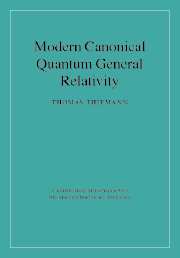Book contents
- Frontmatter
- Contents
- Foreword, by Chris Isham
- Preface
- Notation and conventions
- Introduction: Defining quantum gravity
- I CLASSICAL FOUNDATIONS, INTERPRETATION AND THE CANONICAL QUANTISATION PROGRAMME
- 1 Classical Hamiltonian formulation of General Relativity
- 2 The problem of time, locality and the interpretation of quantum mechanics
- 3 The programme of canonical quantisation
- 4 The new canonical variables of Ashtekar for General Relativity
- II FOUNDATIONS OF MODERN CANONICAL QUANTUM GENERAL RELATIVITY
- III PHYSICAL APPLICATIONS
- IV MATHEMATICAL TOOLS AND THEIR CONNECTION TO PHYSICS
- References
- Index
3 - The programme of canonical quantisation
Published online by Cambridge University Press: 04 August 2010
- Frontmatter
- Contents
- Foreword, by Chris Isham
- Preface
- Notation and conventions
- Introduction: Defining quantum gravity
- I CLASSICAL FOUNDATIONS, INTERPRETATION AND THE CANONICAL QUANTISATION PROGRAMME
- 1 Classical Hamiltonian formulation of General Relativity
- 2 The problem of time, locality and the interpretation of quantum mechanics
- 3 The programme of canonical quantisation
- 4 The new canonical variables of Ashtekar for General Relativity
- II FOUNDATIONS OF MODERN CANONICAL QUANTUM GENERAL RELATIVITY
- III PHYSICAL APPLICATIONS
- IV MATHEMATICAL TOOLS AND THEIR CONNECTION TO PHYSICS
- References
- Index
Summary
In this chapter we give a systematic description of which steps the method of canonical quantisation consists of. The basic idea, due to Dirac, is that one quantises the unconstrained phase space, resulting in a kinematical Hilbert space and then imposes the vanishing of the constraints as operator equations on physical states. The motivation behind this ‘quantisation before constraining’ is that in the opposite procedure one would need to know the full set of Dirac observables. This may not only be practically hard even classically as in the case of interacting field theories such as GR but, even if the full set of Dirac observables could be found, it could be very hard to find representations of their corresponding Poisson algebra, see, for example, [189, 205, 260] and the previous chapter.
Thus, Dirac quantisation is a way to enter the quantum regime even if the underlying classical system is too complicated in order to find all its gauge invariants. While it will be even harder to find all the quantum Dirac observables, the real advantage is that (1) in a concrete physical situation we only need a few of these invariants rather than all of them and (2) starting from the kinematical representation of non-observable quantities we automatically arrive at an induced representation of the invariants which can be expressed in terms of the non-observables.
The canonical approach is ideally suited to constructing background metric-independent representations of the canonical commutation relations as is needed, for example, in quantum gravity. Dirac's original work was subsequently refined by many authors, see, for example, [16, 17, 266–278]. In what follows we present a modern account.
- Type
- Chapter
- Information
- Modern Canonical Quantum General Relativity , pp. 107 - 117Publisher: Cambridge University PressPrint publication year: 2007



